#leo castelli gallery records
Photo



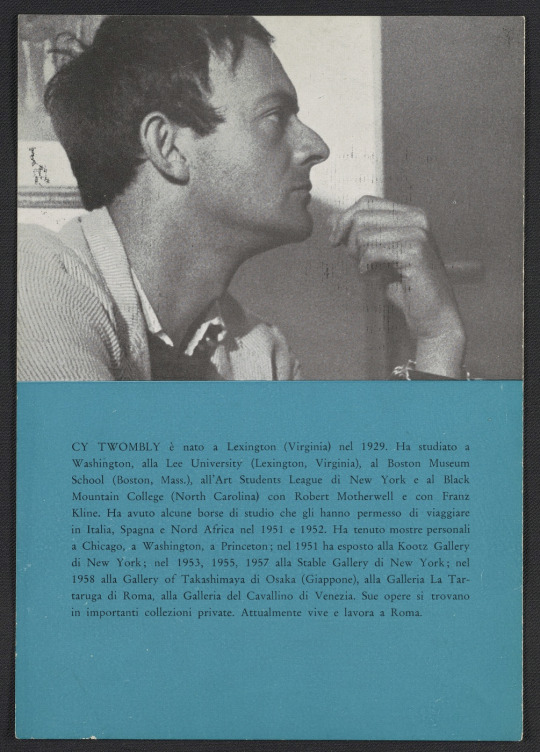
Cy Twombly, Text by Palma Bucarèlli, Galleria del Naviglio, Milano, 1958 [Exhibition: November 1-10, 1958] [Leo Castelli Gallery records, circa 1880-2000, bulk 1957-1999, Archives of American Art, Smithsonian Institution, Washington, D.C.]
/ l'Altissimo /
#graphic design#typography#art#drawing#visual writing#exhibition#catalogue#catalog#cover#back cover#cy twombly#palma bucarèlli#galleria del naviglio#leo castelli gallery records#archives of american art#smithsonian institution#1950s
69 notes
·
View notes
Photo

(▶︎ Solos | Dickie Landry (feat. Richard Peck, Robert Prado, Rusty Gilder, Jon Smith, Alan Braufman, David Lee) | Unseen Worldsから)
Solos by Dickie Landry (feat. Richard Peck, Robert Prado, Rusty Gilder, Jon Smith, Alan Braufman, David Lee)
On February 19, 1972, a crew of mostly Louisiana-raised musicians came together at the Leo Castelli Gallery on West Broadway in Soho to perform a wholly improvised concert. This ensemble’s solos spring from collective improvisations and a tumultuous backbeat, loosely inspired by the creations of Coltrane, Coleman, Albert Ayler, and their brethren. The de facto leader was Richard “Dickie” Landry, a saxophonist and keyboardist who joined composer Philip Glass’s group in 1969. Landry had become a fixture in downtown New York’s loft and art scenes at the close of the 1960s, after he high-tailed it by car from Louisiana to the Lower East Side and auspiciously encountered Ornette Coleman at the Village Gate the night of his arrival.
For this concert, fellow Glass reedists Jon Smith and Richard Peck joined in, alongside Rusty Gilder and Robert Prado, both doubling on bass (upright and electric) and trumpet. The drum chair was occupied by New Orleans firecracker David Lee, Jr., who brought alto saxophonist Alan Braufman along for the session (Braufman was the only non-Louisiana player in the band). The ensemble stretched out in the gallery for several hours in a configuration reflecting those that took place at Landry’s Chinatown loft, documented in photos by artists Tina Girouard and Suzanne Harris that adorn the inside of the original gatefold album jacket. Recorded live by Glass’ sound engineer Kurt Munkacsi, the album was released as a double LP on Chatham Square, the small imprint Landry and Glass co-ran, in a stark greyscale cover and simply titled Solos. The order of the players’ improvisations was laid out on the album inner labels, though unsurprisingly there’s a fair amount of blend. At the end of the day Solos is beyond category, a rousing exploration of instrumentation, rhythm, and life.
This first-time reissue is remastered from the original master tapes, released as a 2LP gatefold with period photos and new liner notes by Clifford Allen, and an additional 30 minutes of bonus material in the digital edition, included with the download code. クレジット2022年10月7日リリース
For Bobby Ramirez
Dickie Landry: Tenor & Soprano Sax, Electric Piano
Richard Peck: Tenor Sax
Robert Prado: Trumpet & Bass
Rusty Gilder: Trumpet & Bass
Jon Smith: Tenor Sax
Alan Braufman: Alto Sax
David Lee: Drums
Kurt Munkacsi: Engineer, 16 Track Skully, Butterfly Productions, Inc
Recorded Live Feb. 19, 1972
Leo Castelli Gallery, N.Y.C., 420 W. Broadway
Tina Girouard: Photographs, Cover
Suzanne Harris: Photographs
D. Norsen: Layout, Design
Remastering: Stephan Mathieu
Produced by Dickie Landry & Leo Castelli
3 notes
·
View notes
Text
Introductions / first artworks

1.one fact about me art is very new to me I’m a beginner, so this will be very interesting to learn, comprehend, and to value the true meaning of art.
2.
A)It took the artist one month to produce this painting.
B)Left canvas is an American fighter firing a missile at the right canvas coming up on the enemy.
C)This painting was the first exhibited at the Leo Castelli gallery in New York City in 1963.
D)Figurative painting
E)Whaam high auction record 95.4m in 2015
sources:
https://www.myartbroker.com/artist-roy-lichtenstein/articles/whaam-roy-lichtenstein-articleLinks to an external site.
https://www.artsy.net/artwork/roy-lichtenstein-whaam-21Links to an external site.
https://www.tate.org.uk/art/artIworks/lichtenstein-whaam-t00897Links to an external site.
3.Looking at the art I kind of had the same mindset as the painting. Reading the painting and learning about it they get into colors the artist use, lines,etc. The artist makes you look way past just the picture it gives one a different insight. The artist created to different panels that equaled to one picture and one messsage!
1 note
·
View note
Text
Gallery Spotlight: Aida Jones
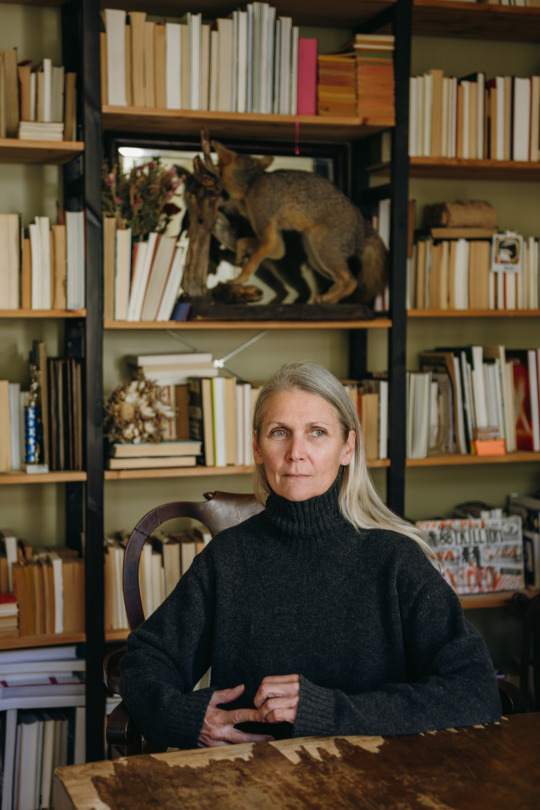
We at Studio AHEAD are excited to announce our latest exhibition, The Lily Too Shall Function, on display at The Jones Institute and the Minnesota Street Project starting November 3. As a sneak peak, we spoke this month with Aïda Jones, founder of The Jones Institute, who shared with us the history of the home gallery, a few thoughts on our show, and what San Francisco was like in the 1990s.
Studio AHEAD: The first striking thing about the Jones Institute is that it is run out of your living room. Can you share with us the history of how this came to be?
Aïda Jones: Impulse was the catalyst. An artist friend was forlorn after being rejected by a gallery and, instinctively, I responded, “I’ll have a show for you.”
It was a leap of faith where Matt Dick, Ruth Kneass, Tjarn Sato, Fletcher, Anton Stuebner, Michael Lee, Wendy Norris, Regina Tsasis, and many many others, generously helped transform my living room into The Jones Institute.
Studio AHEAD: Were there other contexts?
Aïda Jones: The home is the original gallery. We still visit homes—the Uffizi, the Louvre, the Frick—that are now museums. The Walker Art Center in Minneapolis began in TB Walker’s home in the late 19th century and in New York in the 50s, Leo Castelli converted his living room into his first gallery. The New York Times had a wonderful article about apartment galleries a few years back.
Studio AHEAD: Perhaps 500 Capp is San Francisco’s most famous example. Who were your guiding lights in setting this up?
Aïda Jones: I love the idea of shaping culture from the fringes. Of bringing a traditional and formal construct into the domestic space.
Guiding lights are everywhere. Walk out your door and you’ll find thousands of inspirations: the drunk at the wharf, everything in Chinatown, the dahlias in the park, the art in the TL, vendors in the Mission, the cook at Red’s, the amateur opera singer next door rehearsing.
Studio AHEAD: What sort of advantages does this… let’s say DIY approach… bring?
Aïda Jones: Let's not say DIY.
Studio AHEAD: Then what would you call it? Certainly the space itself affects how people view the art.
Aïda Jones: If we have to label it, maybe call it an alternative space. And you’re right, space absolutely affects how people view art. It permeates every bit of their experience. When art is in a home, the sense of place opens them up—the art itself changes the space, it’s a symbiotic relationship you won’t have within the white box. And The Jones Institute is not a commercial place so most people find communing with art is different.
Studio AHEAD: Tell us about a recent exhibition from curator Shirley Watts. Would this be a show a more mainstream gallery could put on?
Aïda Jones: Yes and no. While individually the artists from that show (Gail Wright and Megan Gafford, for example) are exhibited in mainstream galleries, the whole of Altered States would have been impossible. Where else could you sit in a backyard, listening to an audio performance of a brain dissection (Erica van Loon) after taking in Megan Gafford’s irradiated daisies and an Erin Espelie RGB video in the main gallery?
Studio AHEAD: Nowhere else! How does our show, The Lily Too Shall Function, fit into this?
Aïda Jones: The Lily Too Shall Function, being guest curated by Homan and Elena, feels very connected to our programming. First, they chose three Northern California artists among the cohort we choose to exhibit here; and second, they are working their distinct point of view within the domestic space, marrying art with how we live. Very much in our founding ethos. We also have a deep belief in sharing the artistic process, so screening a film of the artists at our satellite location in Minnesota Street Project just makes sense.
Studio AHEAD: You and Homan were speaking off-the-record about the 1990s, on which there is currently a lot of nostalgia in mainstream American culture. What elements of the 90s would you like to see transplanted into the 2020s?
Aïda Jones: This is specific to San Francisco where we are on the edge of the world. The experimentation, the casual spontaneity, the lack of preciousness and belief you could do anything.
In the 90s, I founded AvidFan, a theatre company, and when I cast two actors (who were also female) in The Zoo Story and then True West—this to the New York Times was radical, but in San Francisco, no one blinked.
It happened because of this place as it existed then. The space and freedom. The whole Bay was wide open with possibility (and low rents!). Such amazing support for artists, from studios and rehearsal spaces for musicians, filmmakers, comedians, photographers, spoken word poets, writers, hip-hop/modern/ballet dancers to performance venues and theaters (& a cowboy store on Valencia), many underground & well-known support structures like Film Arts Foundation, New Langton Arts, New College, and so many others.
For a peek into that era see the New Yorker article of the photographer Chloe Sherman’s Renegades (and then buy the book).
Studio AHEAD: What aspect of the 2020s would you have liked to see back in the 90s?
Aïda Jones: The lovely, well-kept city parks. The absence of lingerie shows in downtown bars.
Studio AHEAD: We like to end with some cultural spaces/people in Northern California you’d like to shed light on.
Aïda Jones: Aside from each and every artist I've shown?
Studio AHEAD: Yes.
Aïda Jones: Here is an incomplete list: Aimee Sioux, Reed Awakening, TamaOne, The Farm Stand Art & Music program, Stud Country Queer Line Dancing, Slash Art, For You, the Bolinas Museum, African American Cultural Center, Dancers' Group, Auntie Charlie’s, Werkshack, CCSF Film Department, Arborica, the promise of a NorCal Pacific Standard Time, Catholic Charities’ homeless family shelters, Canyon Cinema, the Bay View Newspaper, Everything the band, Albert Lee, Natural Discourse, NAID, Cushion Works, Lynette Betancur, Donald Guravich, Rachel Marino, the new extension of trails in Marin’s redwood preserve, Originals Vinyl, Li Po, Artists Television Access, CounterPulse, RCA Beach, Day Moon Bread, whatever Natasha Boas is up to, 120710 in Berkeley, Winslow House…
Studio AHEAD: Thank you!
Photos by Ekaterina Izmestieva




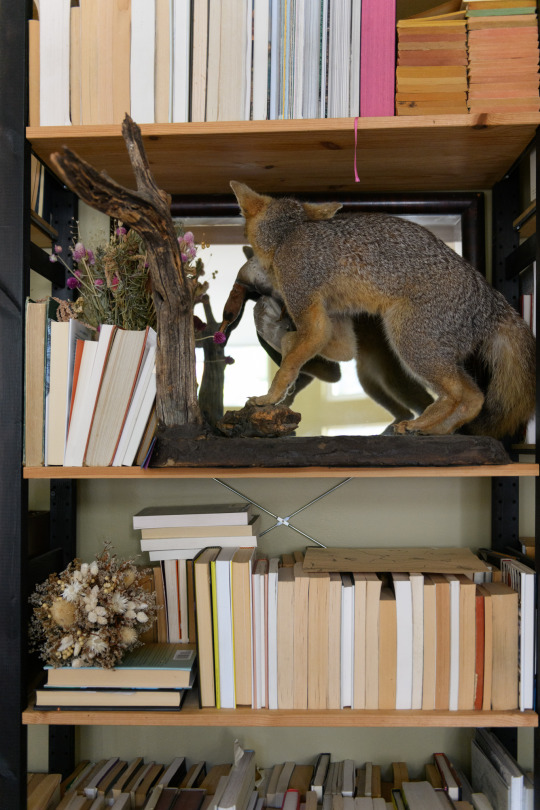

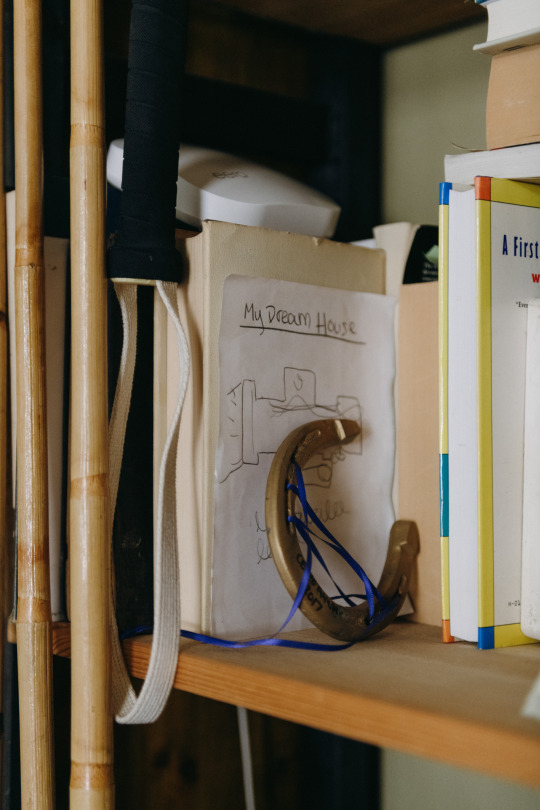


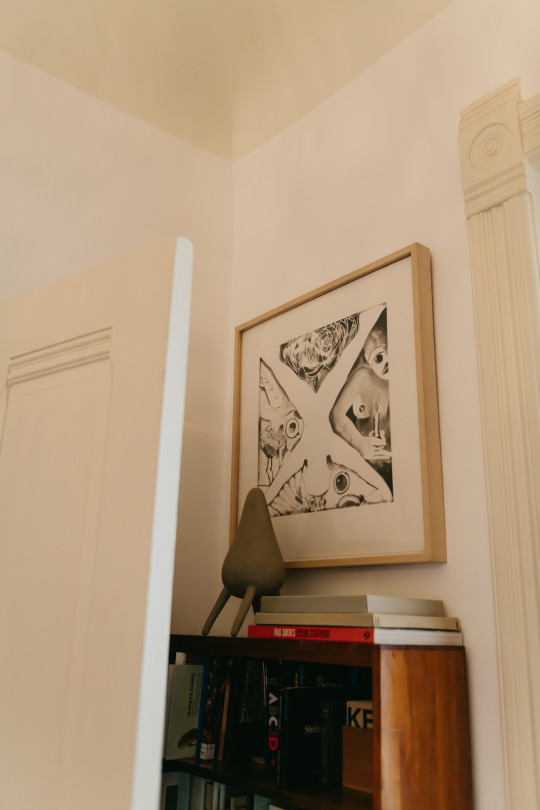
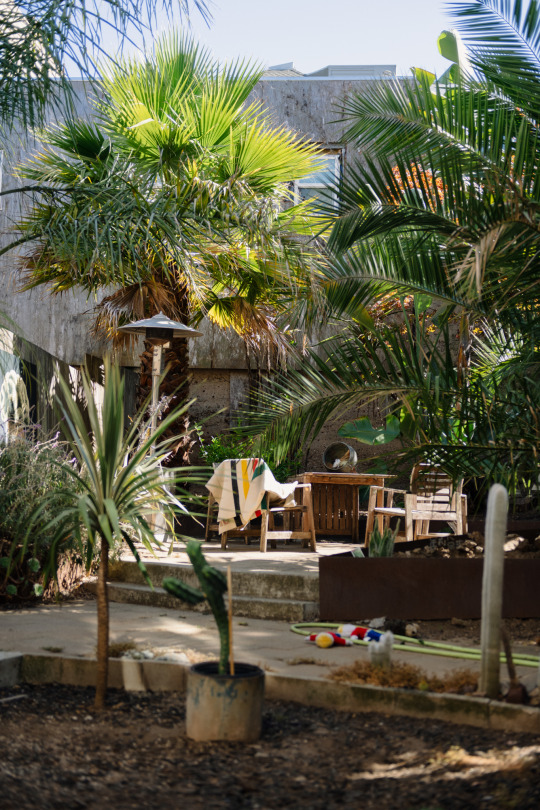
1 note
·
View note
Text

“The Assistant Professor Turned ‘Girl With Ball’ Into Some Freudian Perversion Maybe Because He’s Very Lonely’ 2019. Oil on canvas, 16 × 20"
Sometimes I think art historians don’t do art history very well. In 1961, Roy Lichtenstein was a family man, raising two little boys. He was not making paintings (copying magazine, newspaper and comic clippings) to emphasize orifices and blow up dolls. Graham Bader, Assistant Professor at Rice University, would disagree. His 2010 publication, Hall of Mirrors, is chock full of gooey sexual interpretations of Roy’s intentions with art. Bader writes masterfully, but gee whiz — what a bunch of kinky balderdash!
Professor Bader does not have a degree in “Subjective Interpretations of Someone Else’s Art”, and yet society supplies him an office with a desk and streams of students who pay with their time and money to one day take their seat beside him. Imagine if Howard Zinn, American history historian, wrote that Robert Kennedy used to dress up as a duck and make love to chicken wire. He had no proof — no recorded interview, not even personal anecdote from enemy Brezhnev’s autobiography. Would MIT Press publish wild speculation? Would Rice University tenure such nonsense?
Here is my subjective interpretation, knowing what I know about the world of 1961. Roy was a year and a half out of Oswego. He was a teacher in New Jersey, and his youngest boy a wannabe Mouseketeer. Mouths were not sexual orifices to Roy. Not openly anyway. Not yet. There is no pre-pop evidence that he was a sexually expressive person. He took his Girl With Ball to the Leo Castelli Gallery, and it was the first painting the latter purchased. Maybe Leo thought she had a sexy mouth hole. Roy just copied his beach-bather straight from a Poconos Advertisement in the New York Times. He made the mouth look like the ball, maybe.
Anyway, read the book for yourself. Good writing can be convincing. Bad writing too. I just wish professor Bader wasn’t awarded a hundred grand a year to help push the hordes of living artists further into obscurity holes. Us living painters have much to say about our work. Maybe professor Bader can shift gears in career to spearhead a pedagogic movement in art history a lá Studs Terkel. Teach the young to interview the prolific, professional, living painters. The ones to load their borrowed cars up with work and schlepp their creations all over hell, usually for payment of non-recognition with a pittance for a tip. Once the word is out that there are multitudes ready to tell a story about their lives as artists, total subjectivity (lies) will not dominate the mostly irrelevant, though highly profitable world of contemporary art “scholarship”. Always a win for high end galleries, museums, millionaire speculators, and just a few living artists who “get made” in their time. I bet there are many of us unknowns painting erotic blow up doll holes onto the faces of beach bathers. Some can even do it without a newspaper clipping for help.
Professor Bader, if you don’t know any living painters, then send a grad assistant into the wild to dig. We’re out here waiting, buried in obscurity, passed over by the billionaires on their way to the sex slavery orgy.
Some quotes picked out of chapter three in Hall of Mirrors :
“Lichtenstein’s girl is wearing a uniform, but it is one of bodily freedom and display… she is also shown engaged in a reach so emphatic that it appears [to] be stretching her body before our eyes…”
“…and though her dot-filled corpus intensifies the benday whispers of Lichtenstein’s attendant’s cheeks and lip, it is simultaneously pierced, at precisely the image’s center, by a gaping orifice that suggests both sexual invitation and complete bodily abandon.”
“Consider again Lichtenstein’s bather’s mouth. If the sexual suggestion of this orifice — placed directly at image’s center… is blatant…”
“This mouth rhymes not only with Lichtenstein’s dots, but with the red-and-white beach ball at the painting’s top edge, and with his mentor Sherman’s pedagogical illustrations of the “focal point” deemed crucial for the production of successful works of art, and — most strangely — the exaggerated orifices of plastic sex dolls, which are explicitly suggested by the clear correspondence between orifice and blow-up ball above.”
I put a Dali mustache on Girl With Ball to cool myself down because Bader was making me feel all hot and nasty inside.
#fuel gallery#joy of man's desiring#original art#artists on tumblr#my art#contemporary painting#art#expressionism#painting#art history
1 note
·
View note
Photo

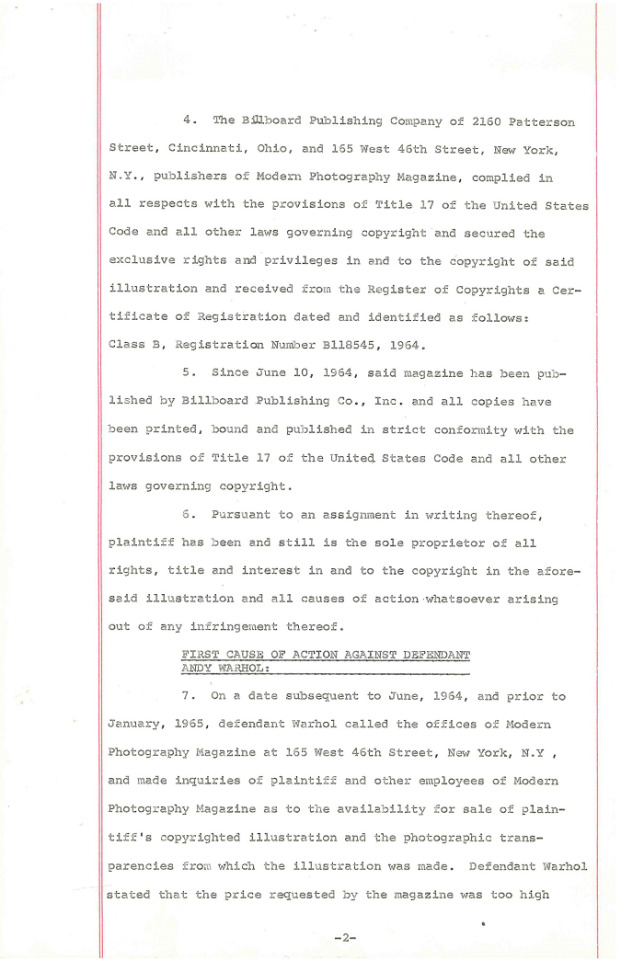

Caulfield v. Warhol, filed 11/9/1966.
“. . . Warhol infringed upon [Caulfield’s] copyright by publishing and placing upon the market no less than thirty paintings entitled "Flowers, 1964", which were copied and reproduced from plaintiff's copyrighted illustration.”
Series: Civil Case Files, 1938 - 1995
Record Group 21: Records of District Courts of the United States, 1685 - 2009
Transcription:
[page 1]
UNITED STATES DISTRICT COURT
SOUTHERN DISTRICT OF NEW YORK
PATRICIA CAULFIELD, CIVIL ACTION NON. 3776
Plaintiff,
-against- COMPLAINT
ANDY WARHOL, LEO CASTELLI, INC.,
d/b/a CASTELLI GALLERIES, LEO
CASTELLI, POSTER ORIGINALS, LTD.,
THE MUSEUM OF MODERN ART, NEW YORK,
BEN BIRILLO, INC., OTTO WITTENBORN
d/b/a WITTENBORN AND COMPANY,
WILLIAM S. ZIERLER, JOHN POWERS,
JOHN DOE AND RICHARD ROE,
Defendants.
[date stamp]
U.S. DISTRICT COURT
FILED
NOV 9 1966
S. D. OF N. Y.
Plaintiff, by her attorney, ARTHUR STEPHEN PENN, complaining of defendants, alleges as follows:
JURISDICTION AND VENUE:
1. The action arises under the copyright laws of the United States, more particularly 17 U. S. C. Secs. 1-116, as herein after more fully appears.
2. Prior to June, 1964, plaintiff, who resides at 115 West 86th Street, New York, N. Y., and who then was and ever since has been a citizen of the United States, photographed and created an original photograph which appeared in whole and in part as illustrations on pages 85, 86, 87 and 88 of Vol. 28, No. 6 of Modern Photography Magazine, more specifically the June, 1964 issue thereof.
3. This photograph is an entirely original photograph by plaintiff, and the illustration thereof, as aforesaid, is copyrightable subject matter under the laws of the United States.
[page 2]
4. The Billboard Publishing Company of 2160 Patterson Street, Cincinnati, Ohio, and 165 West 46th Street, New York, N. Y., publishers of Modern Photography Magazine, complied in all respects with the provisions of Title 17 of the United States Code and all other laws governing copyright and secured the exclusive rights and privileges in and to the copyright of said illustration and received from the Register of Copyrights a Certificate of Registration dated and identified as follows: Class B, Registration Number B118545, 1964.
5. Since June 10, 1964, said magazine has been published by Billboard Publishing Co., Inc. and all copies have been printed, bound and published in strict conformity with the provisions of Title 17 of the United States Code and all other laws governing copyright.
6. Pursuant to an assignment in writing thereof plaintiff has been and still is the sole proprietor of all rights, title and interest in and to the copyright in the aforesaid illustration and all causes of action whatsoever arising out of any infringement thereof.
[underline] FIRST CAUSE OF ACTION AGAINST DEFENDANT ANDY WARHOL: [end underline]
7. On a date subsequent to June, 1964, and prior to January, 1965, defendant Warhol called the offices of Modern Photography Magazine at 165 West 46th Street, New York, N. Y. and made inquiries of plaintiff and other employees of Modern Photography Magazine as to the availability for sale of plaintiff's copyrighted illustration and the photographic transparencies from which the illustration was made. Defendant Warhol stated that the price requested by the magazine was too high
-2-
[page 3]
and declined to purchase.
8. Thereafter, on information and belief, on a date subsequent to June, 1964, and prior to January, 1965, defendant Warhol caused to be made, from photostatic reproductions of plaintiff's copyrighted illustration, a number of silk screens of varying sizes, and by a technique of forcing paint through such screens "mass produced" not less than thirty copies of plaintiff's copyrighted illustration.
9. On information and belief, defendant Warhol applied by hand, at most, mere dabs of paint as highlights, since it was his intention to make all of the aforesaid paintings as similar to the others as was possible.
10. On information and belief, on or about January, 1965, defendant Warhol infringed upon the aforesaid copyright by publishing and placing upon the market no less than thirty paintings entitled "Flowers, 1964", which were copied and reproduced from plaintiff's copyrighted illustration.
11. A copy of plaintiff's copyrighted illustration is hereto attached as Exhibit 1; a photograph of many of defendant Warhol's infringing paintings is hereto annexed as Exhibit 2.
12. Plaintiff has notified defendant Warhol in writing that he has infringed the aforesaid copyright, and defendant Warhol has continued to infringe the aforesaid copyright.
13. Since January, 1965, and continuously thereafter, defendant Warhol has been publishing, selling and otherwise
-3-
#archivesgov#November 9#1966#1960s#Andy Warhol#art#MoMa#copyright#copyright infringement#pop art#Flowers
34 notes
·
View notes
Photo




John Chamberlain via Leo Castelli Gallery records, circa 1880-2000, bulk 1957-1999
10 notes
·
View notes
Photo

Talking Heads’ Speaking In Tongues clear limited edition vinyl at ‘On The Record’ vinyl / music exhibition; Stony Brook, New York (Summer 2016). David Byrne had approached Bob Rauschenberg to re-do an album cover after observing his artwork at Leo Castelli’s West Broadway gallery and this was the result. Four discs comprise the entire package. One disc was the album on clear vinyl and the other three discs were made of clear primary colors of cyan, magenta, and yellow containing the album information. All three primary-colored discs line up properly to produce the full-color image, though Rauschenberg himself intentionally threw off some of the imaging slightly. 50,000 copies were made.
#VMFX#art#aesthetic#photography#photos#photographers on tumblr#CMYK#cyan#magenta#yellow#key#black#vinyl#colored vinyl#David Byrne#Talking Heads#Bob Rauchenberg#Leo Castelli#wow#whoa
57 notes
·
View notes
Photo


Hanne Darboven letter to Leo Castelli, May 7, 1974 [© Hanne Darboven. Leo Castelli Gallery records, circa 1880-2000, Archives of American Art, Smithsonian Institution, Washington, D.C.]
#art#visual writing#handwriting#pattern#differentiated repetition#correspondence#hanne darboven#leo castelli#leo castelli gallery#leo castelli gallery records#archives of american art#smithsonian institution#1970s
94 notes
·
View notes
Photo




Twombly, Text by Palma Bucarèlli, Galleria del Cavallino, Venezia, 1958 [Exhibition: August 18-27, 1958] [Leo Castelli Gallery records, circa 1880-2000, bulk 1957-1999, Archives of American Art, Smithsonian Institution, Washington, D.C.]
/ l'Altissimo /
#graphic design#art#drawing#visual writing#exhibition#catalogue#catalog#cover#back cover#cy twombly#palma bucarèlli#galleria del cavallino#leo castelli gallery records#archives of american art#smithsonian institution#1950s
36 notes
·
View notes
Photo


Hanne Darboven, Month I (Jan.) 1974, (ink on vellum), [from a set of 31 pages] [© Hanne Darboven. Photo: © Dorothy Zeidman. Leo Castelli Gallery records, circa 1880-2000, bulk 1957-1999, Archives of American Art, Smithsonian Institution, Washington, D.C.]
#art#visual writing#handwriting#drawing#hanne darboven#dorothy zeidman#leo castelli gallery#leo castelli gallery records#archives of american art#smithsonian institution#1970s
15 notes
·
View notes